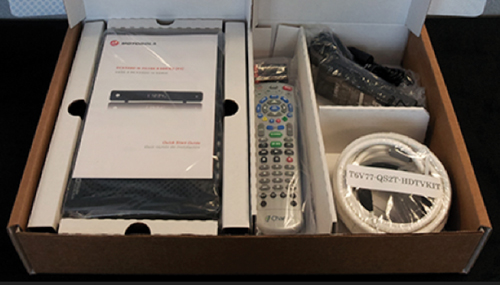“Contactless” Customer Service
By Bill O’Donnell
Since the onset of the Covid-19 pandemic, broadband connections have been in increasingly high demand to support distance learning at all levels of education, home offices with video meeting capability, telemedicine, home shopping and entertainment. Governments from local to national recognize the need for increased investment in broadband infrastructure in order to continue the commerce that is critically necessary for a rapid return to normalcy.
With every new societal event it seems some new vernacular enters our everyday language. One such term heard since the pandemic began is “contactless.” Given the heightened sensitivity to possible virus exposure carried by strangers, this word understandably brings a sense of security to consumers. Proudly, many broadband service providers have embraced a proven “contactless” customer service model for more than a decade.
Before exploring the self-install service model, it makes sense to review the traditional install method which involves a technician visit to the subscriber’s home.
Traditional installation
Typically, a consumer will request service from a chosen broadband provider. During this initial interaction, the provider will schedule a time for a visit by an installation technician. Depending on workload, this visit can be anywhere from “same day” to a week or more in the future.
Once on-site, the technician spends anywhere from 30 minutes to a couple of hours on an installation. Variables include the services being installed, makeup of the existing home infrastructure, accessibility of work area(s) and the customer’s desire for location of service. Additional considerations include dealing with possible house pets, children, home furnishings and the like.
Over the last 20 years technology advances, along with a population that is more comfortable with home electronics, has created an environment in which “do it yourself” installation is a viable approach to broadband service installation. Smarter modems ensure that connections newly installed by a consumer may be tested and troubleshot remotely by a service provider’s technician.
For over a decade, various service providers have had a business model which allows customers to install service provider-supplied equipment. In the past, the main driver behind these initiatives was the operational savings that could be achieved by eliminating a truck roll. With the onset of the Covid-19 pandemic, a new and much more compelling driver emerged — the need to maintain social distance from the very customers served by a provider.

Customer self-install
In March of this year, a once-in-a-century pandemic changed virtually every aspect of American life. Overnight, the home became the center for work, schooling, and entertainment, all delivered over a broadband connection. Demand for service grew exponentially. Charter, for example, saw service requests grow to 10,000 per day, fulfilling over 600,000 requests in 60 days! With the nation’s economy, and psyche, literally hanging on the ability of service providers to respond, the customer self-install model became the “go-to” approach to bring broadband pipes into consumer’s homes.
Like the traditional installation, a customer self-install begins with a service order to the provider. The broadband provider then verifies the ability of the OSP infrastructure that runs into the home to support the desired service(s). With today’s mechanized record-keeping and verification techniques, this can often be performed in real time during the customer’s initial request for service. Assuming satisfactory infrastructure, the customer can be scheduled to receive the appropriate self-install kit (SIK), most often via mail or other delivery service.
The kit itself will vary, depending on a provider’s operational requirements. The kit is designed for completely tool-less installation and will typically consist of:
- Instructions (multilingual)
- Modem (with power cord)
- Wi-Fi router (with power cord)
- Coax cable(s)
- Ethernet cable
- Phone cable
- Coax splitter
- Privacy and other legal notices (multilingual)
- Equipment return card
In keeping with consumer electronics industry trends, kit packaging consists of individually wrapped components, color-coded or labeled cables and connectors, and diagram(s) that visually match the various parts and clearly designate how they are to be connected (see photo).
Upon receipt of the kit, the customer may begin installing their new broadband Internet service. The process consists of two general stages: placement of the equipment, and activation of service. While the specifics may vary slightly between service providers, there are simple written instructions to guide the install.
Equipment Placement
- Choose a location near the coaxial outlet
- Find the appropriate equipment identifier information (e.g., SSID) for a later step
- Connect coaxial cable to equipment and wall outlet
- Connect power cord to equipment and electrical outlet
Service Activation
- Access the Wi-Fi settings on an electronic device (e.g., cell phone)
- Enter the information necessary as was noted in Step 2
- Activation begins and may involve answering questions to customize services and password
There are usually additional resources such as an online video which provides a visual guide to the process and, of course, online or phone-based technical support.
Advantages and drawbacks of the service models
While the customer self-install model was clearly a real help during the chaotic Spring of 2020 due to its ability to allow consumers to gain greater home bandwidth without inviting strangers into their homes, it certainly is not a panacea across all situations. Outlined in the chart is a comparison of some of the main advantages and disadvantages of the two service connection models.
Because there have been millions of homes built across the country over many decades, it is understandable that in-place home wiring varies widely, and often may not support the desired high-speed connection without the intervention of a skilled technician. Technicians may need to test signal strength and perhaps even the connections inside a home. In addition, if multiple services such as home security are to be installed, the install may be beyond that which can reasonably be accomplished using a simple self-install kit. Further, relatively modern infrastructure might still provide a challenge for self-install due to damaged cabling, susceptibility to noise, ingress, etc. Indeed, for the foreseeable future there will likely continue to be a need to have a mobile technician workforce to fulfill service orders that cannot be self-installed.
Lessons of the past decade…and the past several months
As mentioned previously, some broadband providers have had customer self-install programs for the last decade. It was these early adopters that were well-positioned for the challenge presented with the onset of the global pandemic. As Charter Communications CEO Tom Rutledge said when speaking of the company’s experience, “We were fortunate when we got hit with what we did, and with the marketing tactics we employed, that we were able to actually deal with it because we started the quarter in the 55% range of self-installation. We were at about 70% when everything changed and we’re over 90% now for self-installation.” Meanwhile, the company’s CFO, Chris Winfrey, has estimated that each self-install costs Charter roughly a third less than a professional install, meaning the company has added hundreds of thousands of new subscribers at a lower cost than they would have experienced pre-pandemic.
Comcast’s self-install model is referred to as “home drop-off.” This program maintains the goal of keeping distance between Comcast employees and consumers while still allowing technicians to test the signal strength outside of a home prior to dropping off the needed equipment. Once the SIK is in the customer’s hands, the technician can connect with the homeowner to “supervise” the install. Once activation is successful the field tech can move on to their next appointment. This novel approach protects both participants by ensuring “social distancing” throughout the process.
Throughout the pandemic, broadband service providers have been met with many questions. Could the network handle the increase in bandwidth demanded by homebound consumers? How would the business manage those customers challenged with the need to have connectivity for their children to attend school, while suffering a layoff or furlough? And, of course, how to deal with the unprecendented demand for new or enhanced broadband connections? Fortunately, many providers found themselves prepared to positively respond to every challenge presented to them. In the case of new service provision, it is clear that those providers that had self-install programs in place were most ready to rise to the challenge.

Typical self-install kit

Bill O’Donnell,
Director of Product Management,
Amphenol Broadband Solutions
bodonnell@abs-go.com
Bill O’Donnell is the Director of Product Management for Amphenol Broadband Solutions and has been working in the telecommunications industry for over 20 years. In this role, Bill works with network providers to help define their challenges for which he draws on the corporation’s global resources to develop innovative solutions.



